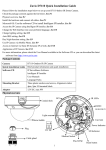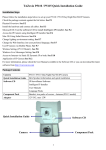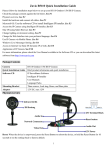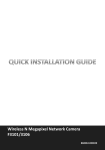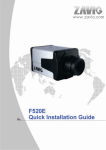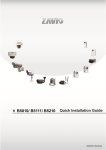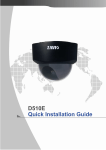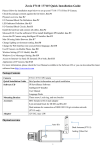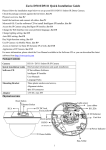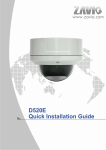Download Zavio D6111 Installation guide
Transcript
Zavio D6111 Quick Installation Guide Please follow the installation steps below to set up your D6111 Vandal Dome Camera. Check the package contents against the list below. See P.1 Physical overview. See P.2 Install the hardware and connect all cables. See P.3 Microsoft OS: Use the software CD to install Intelligent IP Installer. See P.7 Access the IP Camera using Intelligent IP Installer. See P.7 Change light environment setting. See P.9 Mac OS using Safari Browser. See P.10 Change the Web Interface into your preferred language. See P.10 Use IP Camera via Mobile Phone. See P.10 Windows Live Messenger Setting. See P.10 Access to Internet via Static IP, Dynamic IP or both. See P.13 Application of IP Camera. See P.15 For more information, please check the User Manual available in the Software CD or you can download the latest software from http://www.zavio.com Package Contents Camera D6111 Megapixel Vandal Dome IP Camera Quick Installation Guide Brief product information and quick installation Software CD IP Surveillance Software Intelligent IP Installer User Manuals Language Packs Accessory Special hex wrench for temper-proof screw Cable gland Screw pack for wall and ceiling mounting Silicon gel packet * 3 Drill template JACK BNC Female to RCA Male 2 pin terminal blocks for power 4 pin terminal blocks for DI/DO 5 pin terminal blocks for audio Wall Mounting Bracket (optional) Bracket Screw pack for mounting Allen key Adaptor (optional) 12V DC, max 6W 1 Physical overview Dome cover Reset button Rugged dome RCA Wire clip Conduit hole plug Cable gland Cable gland Claw Thread-lock sealing nut Note: The size of Cable gland is M20*1.5 2 Install the hardware and connect all cables a. Installer the hardware 1. Loosen the tamper-proof screws using supplied special hex wrench and remove the dome cover from the rugged dome. Be careful do not scratch the cover glass. 2. Disassemble the cable gland. 3. Thread the network and I/O cable (power/audio/digital input and digital output) through thread-lock sealing nut, claw (using the claw to round all cable) and cable gland. To seal all cable in the claw part tightly in case of water leaking. 4. Attach the cable gland to the conduit hole on the side or bottom of the rugged dome. Push the claw into the cable gland and tighten thread-lock sealing nut to secure the cables. 5. Use the supplied blind plug to fill unused conduit hole. 6. Use the drill template, drill four holes in the ceiling or wall. The conduit hole should face downwards if the camera is installed vertically. 7. Install the rugged dome on the ceiling or wall using the supplied screws. Seal the holes with silicon sealant to prevent moisture from leaking in to the dome. 8. Use the cable gland is optional. For vandal-proof requirement of the cables, use vandal-proof conduits instead. 9. Turn the lens to the desired direction. Loosen the zoom puller and rotate the zoom and determine desired zoom position. Loosen focus puller and focus the image. Focus puller Vari-focal Lens Zoom puller 10. After determining zoom and focus, lock the zoom puller and focus puller. 11. Rotate the black protective shield inside the dome to match the camera’s position. 12. Use soft cloth to clean dome cover glass to remove dust and finger prints and also use blower to remove dust from the lens. 13. Remove the protective paper form the adhesive stripe on the side of rugged dome. Place the silica gel pack on the camera unit as suggestion. 14. Cover dome and tighten the tamper-proof screws using the special hex wrench. Note: There might be of moisture problem which isn’t covered by warranty if dome is not installed by this instruction above. 3 b.Wall mounting and Ceiling mounting Plastic anchor nuts 1. Paste the drill template on the Wall or Ceiling which rugged dome desired. 2. Drill four holes in the wall or ceiling and insert plastic anchor nuts into them. 3. Insert the supplied screws into the corresponding anchor nuts and secure them with screwdriver. 4. Cover the rugged dome and tighten the tamper-proof screws using the special hex wrench. Ceiling Supplied screws Wall 4 Bolt c. Wall Mounting with Bracket (Optional) 1. Route network and power cables through wall and allow extending. 2. Loosen the two bolts to rotate bracket to the desired position. 3. Thread all cable through cable gland. 4. Route network cable and power cable, then fixe those with wire clip. 5. Attach cable gland on the conduit hole. 6. Fix wall mounting bracket on rugged dome with four supplied wash and screws. 5 7. Drill four holes and insert plastic anchor nuts into them. 8. Insert the supplied screws into the corresponding anchor nuts and secure them with screwdriver. d1 d. Connect all cables b1. Power over Ethernet (PoE) 1. Using a standard RJ-45 network cable, connect the IP Camera to a PoE-enabled Hub / Switch / Router b2. Without Power over Ethernet (PoE) connection 1. Connect the power adaptor to the IP Camera. 2. Using a standard RJ-45 network cable, connect the IP Camera to a normal Hub / Switch / Router. 6 d2 Microsoft OS: Use the software CD to install Intelligent IP Installer Power on your PC and insert the CD-ROM. The setup page will show up automatically. Please follow those steps to install the firmware. Select “Intelligent IP Installer” and follow the installation process to complete the installation. Access the IP Camera using Intelligent IP Installer 1. Before using Intelligent IP Installer, please check two setting. a. Browser’s Internet Properties → Security → Default Level b. Browser’s Internet Properties → Privacy → Uncheck Pop-up Blocker 7 2. Click the Intelligent IP Installer Icon on your desktop. The main page will show up listing all active camera and video server devices. Select the relevant IP camera from the list and click Link to IE. 3. Enter your Username and Password to login to the IP Camera. (Default is admin / admin) 4. When accessing the IP Camera for the first time, a yellow information bar appears below the address bar: This website wants to install the following add-on: ‘AxvideoView.cab from ‘Zavio Inc’. 5. Click the information bar, and select Install ActiveX control. 8 6. Click Install. 7. Live video displays in the centre of your web browser. Change light environment setting The default setting of lighting environment is Auto. However, you may also select 50 or 60 Hz upon the lighting environment of your country. Go to “Setting → Basic → Camera → Advance", choose the environment setting you wish. 9 Mac OS using Safari Browser 1. Select Safari icon 2. Click Bonjour function and select the camera you wish to access. 3. Enter name and password to login to the IP 4. The monitor image will be displayed in your browser. camera. (Default is admin / admin) 10 Change the Web Interface into your preferred language Use the settings screen to set the language of the Web Interface. Go to “Setting → Basic → System → Language”. 1. Insert Software CD into your CD-ROM. 2. Browse and select the preferred language from language pack in the Software CD and then click OK. 3. The web interface will change into your preferred language. Use IP Camera via Mobile Phone 1. Using IP Camera via iPhone Select Safari function → Enter IP address in the web link → enter username and password (default value admin/admin) → The Zavio user interface and Live Image will show up in the middle of the screen. 2. Mobile phone viewing a. 3G Mobile Phone Streaming Viewing For 3G mobile phone viewing, please type “ rtsp://<IP>:<PORT>/video.3gp ” into your 3G web media player. <IP> is the IP address of your IP camera; <PORT> is the RTSP port of your IP camera (Default value is 554.) Example: rtsp://100.10.10.1:554/video.3gp b. 2.5G Mobile Phone Viewing b1. WAP viewing For 2.5G WAP mobile phone viewing, type “ http://<IP>/mobile.wml ” into your 2.5G web browser. b1. Browser viewing For 2.5G mobile phone browser viewing, type “http:// <IP>/mobile.htm ” into your 2.5G web browser. Windows Live Messenger Setting Live video of the IP Camera can be displayed using Microsoft Live Messenger, whilst providing its public IP address to users for access via the web browser. This feature is useful especially when the IP address of the camera is dynamically assigned. If you wish to set up MSN Messenger, enter the camera’s setting page. Go to “Setting → Basic → System → Network → Messenger”, set the Messenger option “On” 1. Create a new MSN Messenger account (e.g.: Camera at home) for the IP Camera 2. Enter the new MSN Messenger Login account and password within the designated boxes. 3. If your router has firewall function, you have to set the Port Range on this setting page in accordance with the one of firewall. 4. Choose the Video Mode, decide the live view image of messenger received from Computer View (MPEG-4) or Mobile View (3GPP). 5. Under the IP Notification Option, click “On” to enable IP notification to the users. 6. Under the Privacy Option, Click “On” to create an allow list. 7. Use your existing account to login to MSN Messenger. 11 8. Add the new MSN Messenger account (e.g.: Camera at home) to your contact list. 9. The IP Camera will send you a message with its Public IP and Private IP if the IP Notification Option is enabled. 10. Click on the small camera icon. Then, choose “View a new contact's webcam”. Camera at home says: 11. The IP Camera automatically accepts your invitation and its live video is displayed. 12. Click Action button and choose Start control panel to use control panel 13. You can use Snapshot, Image Setup function via MSN add-in control panel. Snapshot Image Setup 12 Access to the Internet a. Internet connectivity of the IP camera can be established by inputting the cameras IP information within the Information section. (Please go to Setting → Basic → Network→ Information) b. Internet Connectivity of the IP Camera can be established through PPPoE (Point-to-Point Protocol over the Ethernet) by inputting the username and password from your Internet Service Provider (ISP) within the PPPoE section. (Please go to Setting → Basic → Network→ PPPoE) Note 1: Please reboot the IP Camera, after changing the PPPoE settings. Note 2: Please turn on the DDNS and IP Notification function when using PPPoE. 13 c. Internet Connectivity of the IP Camera can be established if your router is UPnP (Universal Plug and Play) enabled. The IP camera is automatically detected and added to “My Network Places” on your computer. Please note that only Home Routers manufactured after 2006 support the UPnP function. c1. If your router is a UPnP Internet Gateway Device (IGD), turn on the UPnP function within the UPnP section. (Please go Setting → Basic → Network→ UPnP) Note: If you turn on the UPnP Port Forwarding function, RTSP (Real Time Streaming Protocol) Port information will change to the illustrated value below. c2. If your router is not a UPnP Internet Gateway Device, please setup Port Forwarding or Port Mapping Note 1: Home Routers manufactured before 2006 do not support UPnP IGD function. Note 2: Enterprise Routers do not support UPnP IGD function. 14 Application of IP Camera 15 Memo ………………………………………………………………………………….. ………………………………………………………………………………….. ………………………………………………………………………………….. ………………………………………………………………………………….. ………………………………………………………………………………….. ………………………………………………………………………………….. ………………………………………………………………………………….. ………………………………………………………………………………….. ………………………………………………………………………………….. ………………………………………………………………………………….. ………………………………………………………………………………….. ………………………………………………………………………………….. ………………………………………………………………………………….. ………………………………………………………………………………….. ………………………………………………………………………………….. ………………………………………………………………………………….. ………………………………………………………………………………….. ………………………………………………………………………………….. ………………………………………………………………………………….. ………………………………………………………………………………….. ………………………………………………………………………………….. ………………………………………………………………………………….. ………………………………………………………………………………….. ………………………………………………………………………………….. ………………………………………………………………………………….. Memo ………………………………………………………………………………….. ………………………………………………………………………………….. ………………………………………………………………………………….. ………………………………………………………………………………….. ………………………………………………………………………………….. ………………………………………………………………………………….. ………………………………………………………………………………….. ………………………………………………………………………………….. ………………………………………………………………………………….. ………………………………………………………………………………….. ………………………………………………………………………………….. ………………………………………………………………………………….. ………………………………………………………………………………….. ………………………………………………………………………………….. ………………………………………………………………………………….. ………………………………………………………………………………….. ………………………………………………………………………………….. ………………………………………………………………………………….. ………………………………………………………………………………….. ………………………………………………………………………………….. ………………………………………………………………………………….. ………………………………………………………………………………….. ………………………………………………………………………………….. ………………………………………………………………………………….. …………………………………………………………………………………..

















